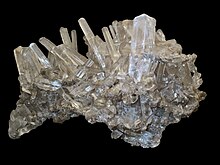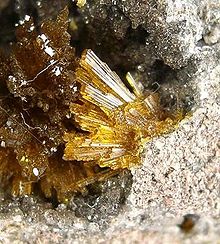Monoclinic crystal system


The monoclinic crystal system ( ancient Greek μόνος mónos "alone", "only" and κλίνειν klinein "incline", "bow") belongs to the seven crystal systems in crystallography . It includes all point groups that have a twofold rotational or rotational inversion axis in exactly one direction . This is the only direction in this crystal system that has a special symmetry. The word monoclinic simply means inclined and refers to the two mutually inclined axes with an angle other than 90 °.
Point groups
The monoclinic crystal system includes the point groups 2, m and 2 / m. They form the monoclinic crystal family and can be described with the monoclinic grid system .
Grid system
The monoclinic grid has the holoedry 2 / m. In the monoclinic crystal system, the direction of the symmetry axis plays a special role, it is therefore also called the monoclinic axis. This axis also corresponds to a direction of the monoclinic grating. The other two grid axes are perpendicular to this axis and form an angle other than 90 °. This angle is also called the monoclinic angle.
There are two lists for the position of the monoclinic axis:
- The monoclinic axis in the c-direction (1st setting). The monoclinic angle is then γ.
- The monoclinic axis in the b-direction (2nd setting). The monoclinic angle is then β.
The 1st setting is rarely used today. As a result, there are also the conditions for the monoclinic grid system (in the 2nd setting):
Contains the structure a two-fold axis of rotation or a 2 1 - screw axis , so this is always parallel to the monoclinic axis. A mirror plane or sliding mirror plane is always perpendicular to this axis. The a- and c-axes are named as follows: If there is no gliding mirror plane, a <c is selected (however, this is not mandatory). If there is a gliding mirror plane, there are two alternatives. Either the c-axis is chosen for the direction of the glide mirror (c glide mirror plane) or the diagonal (a + c / 2) (so-called n glide mirror plane). The axes should be chosen so that the monoclinic angle is as close to 90 ° as possible. In the literature, however, one also finds structure determinations in which the sliding component lies in the direction of the a-axis.
The monoclinic grid system is denoted by m.
Bravais grid
In monoclinics there is a base-centered Bravais lattice in addition to the primitive one . The axes are chosen by convention so that there is always a C-centering. Different setups, mainly the I-centering, are not uncommon, however. The same applies here that the centering should be selected in which the monoclinic angle is as close as possible to 90 °.
Point groups in the monoclinic crystal system and their physical properties
To describe the monoclinic crystal classes in Hermann-Mauguin symbology , the symmetry operations with respect to given directions (viewing directions) are given in the grid system. In the monoclinic, the three viewing directions are the directions of the a (<100>), b (<010>) and c-axis (<001>) of the grid system. If in the detailed Hermann-Mauguin symbol the directions without a symmetry element are designated with 1, then these directions are omitted in the short form. In this case one can no longer differentiate between 1st and 2nd setting.
Characteristic for the space group symbols of the monoclinic crystal system is exactly one axis with a symmetry other than 1.
| Point group (crystal class) | Physical Properties | Examples | ||||||||||
|---|---|---|---|---|---|---|---|---|---|---|---|---|
| No. | Crystal system | Surname | Schoenflies icon | International symbol ( Hermann-Mauguin ) |
Tepid class | Associated room groups ( no.) |
Enantiomorphism | Optical activity | Pyroelectricity | Piezoelectricity ; SHG effect | ||
| Full | Short | |||||||||||
| 3 | monoclinic | monoclinic-sphenoid | C 2 | 121 (or 112) | 2 | 2 / m | 3-5 | + | + | + [010] (or [001]) | + |
Uranophane halotrichite |
| 4th | monoclinic | C s ( C 1 h ) | 1 m 1 (or 11 m ) | m | 6-9 | - | + | + [ u 0 w ] (or [ uv 0]) | + |
Soda Skolezite |
||
| 5 | monoclinic prismatic | C 2 h | 12 / m 1 (or 112 / m ) | 2 / m | 10-15 | - | - | - | - |
Gypsum cryolite |
||
|
||||||||||||
For more monoclinic crystallizing chemical substances see category: Monoclinic crystal system
literature
- Hahn, Theo (Ed.): International Tables for Crystallography Vol. A D. Reidel publishing Company, Dordrecht 1983, ISBN 90-277-1445-2
- D. Schwarzenbach Kristallographie Springer Verlag, Berlin 2001, ISBN 3-540-67114-5
- Will Kleber , Hans-Joachim Bautsch , Joachim Bohm , Detlef Klimm: Introduction to crystallography . 19th edition. Oldenbourg Wissenschaftsverlag, 2010, ISBN 978-3-486-59075-3 .



